For John Grady Cole, the first taste of Mexico after crossing the border illegally was a generous draught of sotol.
The U.S. and Mexican borderlands were different then – no border wall, no Predator drones flying overhead, and no drug war raging. Today, the cattle fences that obstructed Grady’s joy in open range riding are the least of the obstructions in the borderlands. Multiple checkpoints, manned by heavily armed soldiers and drug agents often wearing black ski masks, now make traveling through the borderlands something akin to making your way through an occupied zone.
For too many years, the combination of the border security buildup on the U.S. side and the barrage of reports about horrific drug war violence on the other side bred fear and reluctance.
Recently, the violence that has for years wracked the northern reaches of Chihuahua and Sonora has diminished, and you can also find some reassurance in that there have been no reports that noncitizens are being targeted. My eagerness to return to the deserts, grasslands, and mountains of the Mexican borderlands has been rising over the past year or two. The border security buildup and the unending drug wars have trapped us in our country.
Unlike Grady in Cormac McCarthy’s All the Pretty Horses (or Matt Damon in the film adaptation of the great novel), I didn’t cross on horseback when I began traveling into Mexico’s borderlands a few months ago. But there was something like the same sense of adventure of traveling into unknown parts.
After driving south from Palomas on a new highway, I turned southwest toward Ascensión and then, after a couple of interviews, headed to Janos – an Apache settlement dating back to the 17th century and later a colonial military outpost. Janos, which sits on the banks of the now-dry Rio Casas Grandes, is the gateway to the Paquimé or Casas Grandes ruins that lie about an hour south. Janos is situated almost directly south of the southeast corner of New Mexico’s bootheel.
At sundown I arrived at Rancho La Guadalupana on the eastern outskirts of Janos. Celso Jacquez offered me a copa of sotol – and I relaxed into the spirit and enchantment of Chihuahua.
I didn’t go to Janos to drink sotol, but rather to interview Celso, the former presidente of the Janos Municipio (roughly “county”) and Chihuahua representative on the Border 2012 environmental commission, a binantional project of the Mexican and U.S. governments. His counterpart in New Mexico was Allyson Siwick, the environmental expert and determined activist who directs Silver City’s Gila Resources and Information Project (GRIP).
But concerns about crossborder water depletion and dust pollution fell way that night as I was treated to a glass of reposado sotol – whose alluring aroma seemed to capture the essence of the desert after a long-awaited rain.
An amused Mexican girl served Grady and his buddy Lacey Rawlins mugs of a strong homebrew that is still a favorite drink in mountain towns and the rancherias of Chihuahua, northern Durango, and Coahuila – the only areas of Mexico where the sotol plant grows. Pleasantly plastered, the two young cowboys let their cares drift away as they began their troubled romance with Mexico.
I, however, was treated by Celso and his son Jacobo to an enticing liquor that poured from a bottle of Don Cuco Sotol into a crystal bar glass. “It is truly more of a spirit, like cognac,” explained Jacobo, describing the reposado sotol I started appreciatively sipping. It’s a sotol that is picked, cooked, fermented, distilled, aged, and bottled by the Jacquez family, which owns the Don Cuco Sotol brand.
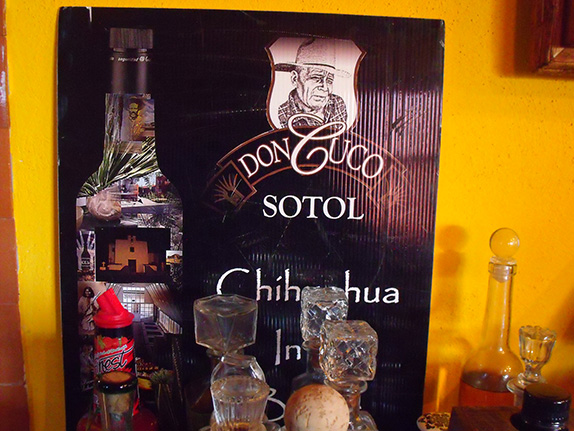
Even before I took my first sip, I knew that work was over for the day. First the rich aroma, faintly smoky but also with a tantalizing allure of the desert after a long-awaited rain. Do you know the song Viva Chihuahua, asked Celso. I did, but hadn’t until then knew the meaning of the verse he began singing: “Tierra que sabe a cariño, Tierra que huele a sotol.” (Chihuahua, “Land that tastes like love, Land that has the aroma of sotol.”)
Since that first drink, I have been, as it were, on the sotol road in Chihuahua, captivated not only by the quality of the spirit but also pursuing sotol’s still largely untold story – one that I am finding out has deep roots in our crossborder history and shared natural world.
There are an abundance of possible starting points for the story. You could start with the sotol plant itself. Its name comes from tzotlllin in nátuatl, is formerly labeled a Dasylirion, is often called sereque in Chihuahua, and is known as the desert spoon on this side. Its thin serrated leaves circle in rosette style the fleshy core or piña, which after 7-15 years produces a magnificent shaft or quiote, elegantly designed to spread its seeds and pollen.
Or you could start the story in Madera with Don Refugio Pérez Marquez – or Don Cuco, as he was affectionately and respectfully known by family and friends in the Sierra Madre. As legend goes, Don Cuco learned the art of sotol selection, fire-pit cooking, fermentation and distilling at least in part from the Tarahumaras who also lived in the mountains around Madera in west-central Chihuahua. His rugged profile appears on the bottles of the Don Cuco brand, which include blanco, suave, reposado, añejo, and crema varieties of sotol.
Don Cuco insisted on the high-quality of his sotol, making certain that the distilled sotol had the exactly right aroma and necklace of bubbles (“collar de perlas”) when shaken and poured. Don Cuco was the grandfather of Celso, whose entire family is involved in the campaign to introduce this spirit of the desert into the U.S. market. It is a product of “Las Generaciónes” – the slogan of this family of five generations of sotoleros.
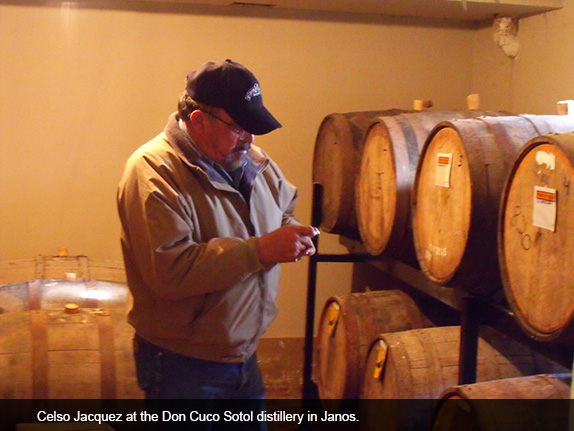
Yet the story of sotol goes much deeper into this history of culture than the mid-1800s. Throughout Chihuahua you will find abandoned and still-used stone-lined fire pits where the sotol piñas are buried and then cooked over two weeks until dripping and succulent with their rich desert sugar. Cooking and fermenting sotol is part of the Raramuri/Tarahumara tradition, but you can also find this same type of firepits in the ruins at Paquimé and in other settlements of their precolonial civilization, which emerged around 200 AD and began flourishing around 1200.
Sotol is also part of Mexico’s revolutionary tradition. Pancho Villa and his army of rebels drank sotol both as an intoxicant and as a tonic. No different than most varieties of liquor, sotol has long been appreciated for its medicinal purposes in Chihuahua – whether to dull pain or to purportedly cure an array of maladies. You may know of the gusano found in the bottom of the bottles of mescal – traditional drink of southern Mexico – and some of us (men) may have even gulped down the mescal-soaked worm in a hopeful attempt to boost virility.
In Chihuahua, folklore has it that drinking sotol that has aged in a bottle containing a rattlesnake can cure just about anything that ails you, including cancer. Telling the story of sotol requires sorting through layers of myths and folktales -- the rural legends of the Sierra Madre.
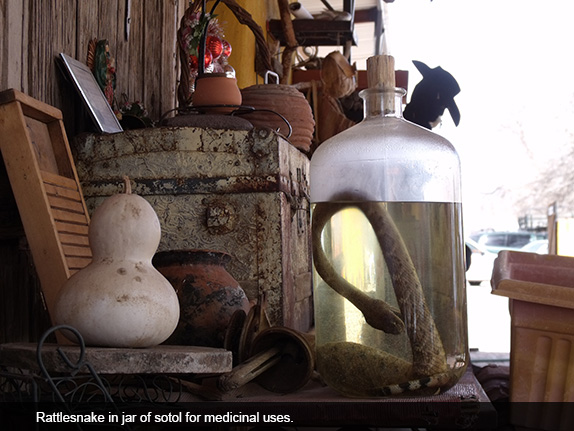
Part of the allure of the sotol story is its history as the traditional home-brewed liquor of peasant revolutionaries, the mysterious and enduring Raramuri people, and the Spanish-speaking mountain men (and women) of the Sierra Madre. When proudly displaying his sotol-soaked snakes, Melquiádes Alvaro, a sotolero in Nuevo Casas Grandes, explained that the rattlesnake sotol cure came not form Raramuri tradition, as is commonly believed. It had a Chinese origin, rather than a Mexican curandero one. As the story goes, in the early 1920s Sonoran judiciales forcibly rounded up and then left Chinese immigrants to their fate in the Chihuahua Desert, and the new Chinese members of the Casas Grandes community soon began mixing rattlesnakes and sotol for miraculous cures.
The tradition of sotol is not limited to the southern reaches of the Chihuahua desert. Sotol grows abundantly in west Texas, southern New Mexico, and southwestern Arizona at elevations between 800 and 2400 meters – but only in rocky well-drained terrain. In times when our nations are so badly divided and when our understanding of each other is rapidly eroding, it’s reassuring to know that the architecturally elegant and drought-proof sotol knows no borders.
But the story of sotol the spirit cannot be told without also telling the story of border control, prohibitions, and smuggling -- and the visionary plans of the Jacquez family to revive the crossborder marketing of sotol. Before Prohibition Era (1919-33) drinking sotol was not uncommon in West Texas. Yet soon after the Prohibition laws started limiting American access to booze, Mexican sotol producers began exporting unprecedented quantities of all varieties and qualities of sotol to meet the illegal demand in the U.S. market.
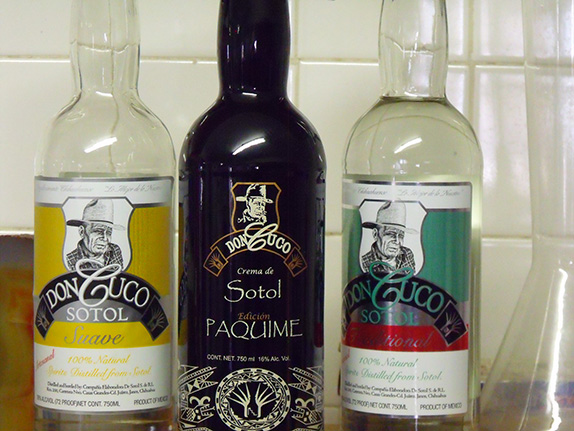
In the end, however, Drug Prohibition proved near-fatal to commercial sotol production in Chihuahua. As soon as the U.S. mafia, together with what are now a couple of elite families of Juárez, began opening up their own production facilities for cheap whiskey and brandy, both sotol industry went into rapid decline. The Mexican sotoleros – burdened with an arduous process of harvesting wild sotol and a long production process -- couldn’t compete with the cheap grain liquor being churned out in Juárez. The new liquor magnates together with their associates in government also began cracking down on the sotoleros – spreading the new narrative that sotol was not the drink of the gente de razón (nonindigenous) but only of the poor and uncouth.
This narrative that sotol is nothing more than a rock-gut, a rústico drink of sandal-clad peasants has over the last century nearly killed the tradition of sotol in Chihuahua, where, like elsewhere in Mexico, cheap tequila and Tecate Lite have come to dominant the alcohol market.
But the Jacquez family is telling a new story about the plant drink that smells like love and the desert to tequila aficionados and influential mixologists (bar tenders who aim to serve the best quality liquors and mixed drinks) say has the potential of creating a niche market for sotol -- perhaps even sparking a boom in sotol demand, mirroring the tequila boom and the current rise of mescal.
The Don Cuco Sotol story is one of family pride in producing over five generation the highest quality of 100% sotol that is wild-harvested, unadulterated (even by water that doesn’t come from the plant itself), and fermented and distilled with care and the wisdom of generations. Sotol, as I have experienced, is a family story.
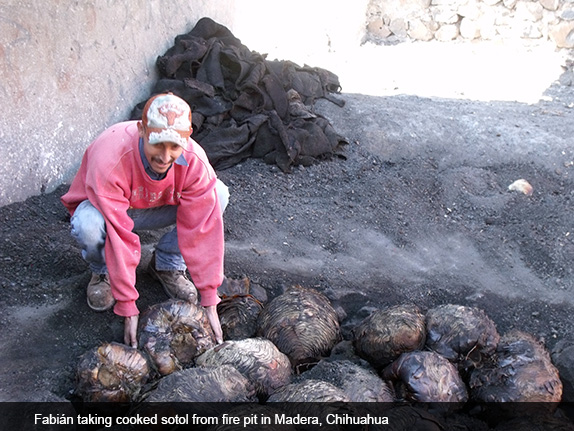
Truth be told. I don’t know much about liquor, let alone the finest of spirits. By no means a connoisseur. A lover of liquor yes, but an expert? Certainly not.
My appreciation of this special family and the enchantment of the land and people of Chihuahua have undoubtedly contributed to my enthusiasm about the quality, cultural import, and potential of Don Cuco Sotol.
But I am not alone. Don Cuco has been winning gold prizes across the nation. In Albuquerque, I sat down to lunch with Mike Morales at the city’s new tequila bar, Zacatecas: Tacos + Tequila. Morales, a self-styled “tequila journalist”, sponsors an annual tequila-tasting contest and consults nationally for liquor distributors and destination bars. So with my own credibility in question, I will quote someone who is nationally recognized as an expert in Mexican spirits.
"I fell in love with this family's spirit as soon as I inhaled it!” Morales told me. “To me, Don Cuco Sotol carries the best of all worlds. It opens up – blooms -- so much that it demands to be treated like a fine wine. It has the smokiness of some of the best mezcals, but the flavor is simultaneously reminiscent of the best tequilas and then, not at all.”
As a former salesman and closer observer of the liquor industry, Morales knows well that the story and image behind the product are critical to good marketing. But what makes the Don Cuco Sotol so unusual is that not only that the story is so appealing but also that it is so true – in marked contrast to most of the “lies of the liquor industry.”
“There is no mistaking that Don Cuco Sotol is product--handcrafted, micro-distilled--and lovingly brought into the market by the Jacquez family," Morales told me.
Fortunately, I am still on the sotol road. Many more stories to hear and tell. Many more copas to drink.
You can buy a bottle of Don Cuco Sotol at the Pink Store in Palomas or buy it at many online outlets. And if you are ready for fun and adventure, if you feel that it is time to reconnect the U.S. and Mexico borderlands, visit the Don Cuco distillery in Janos and then continue on to Casas Grandes and Paquimé. You may also want to visit the Don Cuco Sotol website and watch the great video about sotol.




Responses to “A Sotol Story”